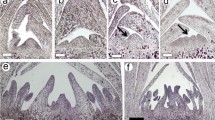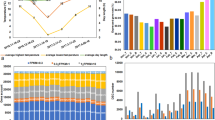Abstract
Grapevine buds exhibit endodormancy (ED), triggered by short days (SD) and terminated through prolonged exposure to low temperature (LT). This study aims to unravel the genetic underpinnings the initiation and cessation of ED. Through previously reported SD-related gene expression changes and comparison with RNA-seq analysis of grapevine buds subjected to LT, we elucidated distinct gene clusters with contrasting regulation patterns. One cluster termed “Thermoregulatory Clock Cluster” encompassed 46 differential expressed genes (DEGs) upregulated by SD but downregulated under LT condition. Functional analysis revealed enrichment in circadian clock and temperature responsiveness functions. In contrast, the “Growth Control Cluster” comprising 292 DEGs downregulated under SD but upregulated under LT, is enriched in functions associated with cell division and transcription regulation. This investigation underscores the pivotal roles of genes associated with circadian clock, temperature responsiveness, cell division and transcriptional regulation in orchestrating the entry and exit of grapevine buds from ED. Furthermore, we propose a mechanistic model wherein LT-induced repression of circadian clock genes provokes the upregulation of SD-suppressed genes that promote ED. Thus, the role of LT in releasing buds from ED can be understood at the molecular level. This study not only advances our understanding of the genetic basis of bud ED, but also holds implications for viticulture and broader insights into plant dormancy regulation.





Similar content being viewed by others
References
Bieniawska Z, Espinoza C, Schlereth A, Sulspice R, Hincha DK, Hannah M (2008) Disruption of the Arabidopsis circadian clock responsible for the extensive variation in the cold-responsive transcriptome. Plant Physiol 147:263–279
Campoy JA, Ruiz D, Egea J (2011) Dormancy in temperate fruit trees in a global warming context: a review. Sci Hortic 130:357–372
Carbonneau A, Deloire A, Torregrosa L, Jaillard B, Pellegrino A, Métay A, Ojeda H, Lebon E, Abbal P (2015) Traité de la Vigne, Physiologie, Terroir, Culture, 2nd edn. Editions Dunod, p 573
Chang S, Puryear J, Cairney J (1993) A simple and efficient method for isolating RNA from pine trees. Plant Mol Biol Rep 11:113–116
Cragin J, Serpe M, Keller M, Shellie K (2017) Dormancy and cold hardiness transition in wine grape cultivars Chardonnay and Cabernet Sauvignon. Am J Enol Viti 68:195–202
Dantas D, Bressan-Smith R, Noriega X, Pérez FJ (2020) Italia melhorada grapevines grown under tropical conditions develop a quiescent state. Environ Exp Bot 171:103951
Díaz-Riquelme J, Grimplet J, Martínez-Zapater JM, Carmona MJ (2012) Transcriptome variation along bud development in grapevine (Vitis vinifera L.). BMC Plant Biol 12:181
Ding J, Nilsson O (2016) Molecular regulation of phenology in trees—because the seasons they are a-changing. Curr Opin Plant Biol 29:73–79
Erez A (1987) Chemical control of budbreak. HortScience 22:1240–1243
Farshadi E, van der Horst GTJ, Chaves I (2020) Molecular links between the circadian clock and the cell cycle. J Mol Biol 432:3515–3524
Fennell A, Schlauch KA, Gouthu S, Khadka S, Sreekantan L, Grimplet J, Cramer, Mathiason KL (2015) Short day transriptomic programming during induction of dormancy in grapevine. Front Plant Sci 6:834
Grant TNL, Gargrave J, Dami IE (2013) Morphological physiological, and biochemical changes in Vitis genotype in responses to photo-period regimes. Am J Enol Viti 64:466–475
Ibañez C, Ramos A, Acebo P, Contreras A, Casado R, Allona I, Argoncillo C (2008) Overall alteration of circadian clock gene expression in the Chesnut cold response. PLoS ONE 3:e3567
Khalil-Ur-Rehman M, Sung L, Li CX, Faheem M, Wang W, Tao JM (2017) Comparative RNA-seq based transcriptome analysis of bud dormancy in grape. BMC Plant Biol 17:18
Kovaleski AP, Reisch BI, Londo JP (2018) Deacclimation kinetics as a quantitative phenotype for delineating the dormancy transition and thermal efficiency for budbreak in Vitis species. AoB Plants 10:1–12
Kühn N, Ormeño-Nuñez J, Jaque-Zamora G, Pérez FJ (2009) Photoperiod modifies the diurnal expression profile of VvPHYA and VvPHYB transcripts in field grown grapevine leaves. J Plant Physiol 166:1172–1180
Lang GA, Early JD, Martin GC, Darnell RL (1987) Endo-, para-, and ecodormancy: physiological terminology and classification for dormancy research. HortScience 22:371–377
Li X, Ma D, Lu SX, Hu X, Huang R, Liang T, Xu T, Tobin EM, Liu H (2016) Blue-light and low temperature-regulated COR27 and COR28 play roles in the circadian clock. Plant Cell 28:2755–2769
Li X, Zhiwei Z, Ma D, Zhang J, Yang Y, Liu Y, Liu H (2020) COR27 and COR28 are novel regulators of the COP1-HY5 hub and photomorphogenesis in Arabidopsis. Plant Cell 32:3139–3154
Livak KJ, Schmittgen TD (2001) Analysis of relative gene expression data using real time quantitative PCR and the 2-ΔΔCT methods. Methods 25:402–408
Londo JP, Johnson LM (2014) Variation in the chilling requirement and budburst rate of wild Vitis species. Environ Exp Bot 106:138–147
Mathiason K, He D, Grimplet J, Venkateswari D, Galbraith DW, Or E (2009) Transcript profiling in Vitis riparia during chilling requirement fulfillment reveals coordination of gene expression pattern with optimized budbreak. Funct Integr Genomics 9:81–96
Nishitani C, Siro T, Ubi BE, Shimazu T, Itai A, Saito T, Yamamoto T, Moriguchi T (2012) Transcriptome analysis of Pyrus pyrifolia leaf during transition from endodormancy to ecodormancy. Sci Hort 147:49–55
Noriega X, Rubio S, Pérez FJ (2022) Sucrose accumulation and endodormancy are synchronized events induced by short-day photoperiod in grapevine buds. Plant Physiol Biochem 190:101–108
Parada F, Noriega X, Dantas D, Bressam-Smith, Pérez FJ (2016) Differences in respiration between dormant and non-dormant buds suggest the involvement of ABA in the development of endodormancy in grapevines. J Plant Physiol 201:71–78
Pérez FJ, Rubio S (2022) Relationship between bud cold hardiness and budbreak in two Vitis vinifera cultivars, Chardonnay, and Thompson seedless. J Plant Growth Regul 41:840–847
Petterle A, Karlberg A, Bhalerao RP (2013) Daylength mediated control of seasonal growth patterns in perennials trees. Curr Opin Plant Biol 16:301–306
Raudvere U, Kolsberg L, Kuzmin I, Arak T, Adler P, Peterson H, Vilo J (2019) g:Profiler: a web server for functional enrichment analysis and conversions of gene list. Nucleic Acids Res. https://doi.org/10.1093/nar/gkw199
Rohde A, Bhalerao RP (2007) Plant dormancy in the perennial context. Trends Plant Sci 12:217
Rubio S, Dantas D, Bressan-Smith R, Pérez FJ (2016) Relationship between endodormancy and cold hardiness in grapevine buds. J Plant Growth Regul 35:266–275
Singh RK, Svystun T, AlDahmash B, Jonsson AM, Bhalerao RP (2017) Photoperiod and temperature-mediated control of phenology in trees—a molecular perspective. New Phytol 213:511–524
Smita S, Robben M, Deuja A, Accerbi M, Green PJ, Subramanian S, Fennell A (2021) Integrative analysis of gene expression and miRNA reveal biological pathways associated with bud paradormancy and endodormancy in grapevine. Plants 10:669
Tarancón C, Gonzáles-Grandío E, Oliveros JC, Nicolas M, Cubas P (2017) A conserved carbon starvation response underlies bud dormancy in woody and herbaceous species. Front Plant Sci 8:788
Velappan Y, Signorelli S, Considine MJ (2017) Cell cycle arrest in plants: what distinguishes quiescence, dormancy and differentiated G1? Ann Bot 120:495–509
Vergara R, Noriega X, Aravena KS, Prieto H, Pérez FJ (2017) ABA represses the expression of cell cycle genes and may modulate the development of endodormancy in grapevine buds. Front Plant Sci 8:812
Wang L, Feng Z, Wang X, Zhang X (2010) DEGseq: an Rpackage for identifying differentially expressed genes from RNA-seq data. Bioinformatics 261(1):136–138
Yamame H, Singh AK, Cooke JEK (2021) Plant dormancy research: from environmental control to molecular regulatory networks. Tree Physiol 41:523–528
Yang Q, Gao Y, Wu X, Moriguchi T, Bai S, Teng Y (2021) Bud endodormancy in deciduous fruit trees: advances and prospects. Hortic Res 8:139
Acknowledgements
The financial support of Fondo Nacional de Ciencia y Tecnología (FONDECYT), is gratefully acknowledged.
Author information
Authors and Affiliations
Contributions
XN perform RT-qPCR experiments. SR perform analysis of RNA-seq results and FJP plan the experiments and wrote the manuscript.
Corresponding author
Ethics declarations
Conflict of interest
There is no conflict of interest.
Additional information
Publisher's Note
Springer Nature remains neutral with regard to jurisdictional claims in published maps and institutional affiliations.
Supplementary Information
Below is the link to the electronic supplementary material.
Rights and permissions
Springer Nature or its licensor (e.g. a society or other partner) holds exclusive rights to this article under a publishing agreement with the author(s) or other rightsholder(s); author self-archiving of the accepted manuscript version of this article is solely governed by the terms of such publishing agreement and applicable law.
About this article
Cite this article
Rubio, S., Noriega, X. & Pérez, F.J. Genes contrastingly regulated by short days and low temperature are key players in the onset and cessation of endodormancy in grapevine buds. Plant Growth Regul (2024). https://doi.org/10.1007/s10725-024-01156-8
Received:
Accepted:
Published:
DOI: https://doi.org/10.1007/s10725-024-01156-8




